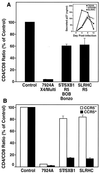Cytopathicity of human immunodeficiency virus type 2 (HIV-2) in human lymphoid tissue is coreceptor dependent and comparable to that of HIV-1
- PMID: 11000231
- PMCID: PMC112391
- DOI: 10.1128/jvi.74.20.9594-9600.2000
Cytopathicity of human immunodeficiency virus type 2 (HIV-2) in human lymphoid tissue is coreceptor dependent and comparable to that of HIV-1
Abstract
Epidemiological studies have shown that human immunodeficiency virus type 2 (HIV-2) is markedly less pathogenic than HIV-1 in vivo. Individuals infected with HIV-2 exhibit a remarkably slow rate of disease development, and these clinical properties have been attributed presumptively to an "attenuated" phenotype of HIV-2 itself. Here, we investigated the impact of coreceptor usage on the cytopathicity of HIV-2 and compared its pathogenic potential with that of HIV-1 in a unique human lymphoid histoculture model. We found that HIV-2 strains, as well as closely related simian immunodeficiency viruses (SIV), displayed mildly or highly aggressive cytopathic phenotypes depending on their abilities to use the coreceptor CCR5 or CXCR4, respectively. A side-by-side comparison of primary X4 HIV-1 and HIV-2 strains revealed similar, high degrees of cytopathicity induced by both HIV types. Furthermore, we found that HIV-2 coreceptor specificity for CCR5 and CXCR4 determined the target cell population for T-cell depletion in lymphoid tissue. Finally, utilization of the alternate coreceptors BOB and Bonzo did not significantly increase the cytopathic properties of HIV-2. These findings demonstrate that coreceptor preference is a key regulator of target cell specificity and the cytopathic potential of HIV-2, with indistinguishable rules compared with HIV-1. Moreover, HIV-2 strains are not characterized by an intrinsically lower cytopathicity than HIV-1 strains. Therefore, direct cytopathic potential per se does not explain the unique behavior of HIV-2 in people, highlighting that other unknown factors need to be elucidated as the basis for their lesser virulence in vivo.
Figures





Similar articles
-
Human immunodeficiency virus type 1 (HIV-1) non-B subtypes are similar to HIV-1 subtype B in that coreceptor specificity is a determinant of cytopathicity in human lymphoid tissue infected ex vivo.J Virol. 2001 Nov;75(21):10520-2. doi: 10.1128/JVI.75.21.10520-10522.2001. J Virol. 2001. PMID: 11581424 Free PMC article.
-
Viral entry through CXCR4 is a pathogenic factor and therapeutic target in human immunodeficiency virus type 1 disease.J Virol. 2000 Jan;74(1):184-92. doi: 10.1128/jvi.74.1.184-192.2000. J Virol. 2000. PMID: 10590105 Free PMC article.
-
CD4-Dependent and CD4-independent utilization of coreceptors by human immunodeficiency viruses type 2 and simian immunodeficiency viruses.Virology. 2000 Dec 5;278(1):276-88. doi: 10.1006/viro.2000.0623. Virology. 2000. PMID: 11112502
-
Genotypic coreceptor analysis.Eur J Med Res. 2007 Oct 15;12(9):453-62. Eur J Med Res. 2007. PMID: 17933727 Review.
-
Structure-function studies of the HIV-1 coreceptors.Semin Immunol. 1998 Jun;10(3):237-48. doi: 10.1006/smim.1998.0130. Semin Immunol. 1998. PMID: 9653050 Review.
Cited by
-
Direct evidence of lower viral replication rates in vivo in human immunodeficiency virus type 2 (HIV-2) infection than in HIV-1 infection.J Virol. 2007 May;81(10):5325-30. doi: 10.1128/JVI.02625-06. Epub 2007 Feb 28. J Virol. 2007. PMID: 17329334 Free PMC article.
-
Coreceptor phenotype of natural human immunodeficiency virus with nef deleted evolves in vivo, leading to increased virulence.J Virol. 2002 Jul;76(14):6966-73. doi: 10.1128/jvi.76.14.6966-6973.2002. J Virol. 2002. PMID: 12072497 Free PMC article.
-
HIV-1 Vpr enhances viral burden by facilitating infection of tissue macrophages but not nondividing CD4+ T cells.J Exp Med. 2001 Nov 19;194(10):1407-19. doi: 10.1084/jem.194.10.1407. J Exp Med. 2001. PMID: 11714748 Free PMC article.
-
Comparison of human immunodeficiency virus (HIV)-specific T-cell responses in HIV-1- and HIV-2-infected individuals in Senegal.J Virol. 2004 Dec;78(24):13934-42. doi: 10.1128/JVI.78.24.13934-13942.2004. J Virol. 2004. PMID: 15564501 Free PMC article.
-
HIV-2 genomic RNA accumulates in stress granules in the absence of active translation.Nucleic Acids Res. 2014 Nov 10;42(20):12861-75. doi: 10.1093/nar/gku1017. Epub 2014 Oct 28. Nucleic Acids Res. 2014. PMID: 25352557 Free PMC article.
References
-
- Albert J, Nauclér A, Böttiger B, Broliden P A, Albino P, Ouattara S A, Björkegren C, Valentin A, Biberfeld G, Fenyö E M. Replicative capacity of HIV-2, like HIV-1, correlates with severity of immunodeficiency. AIDS. 1990;4:291–295. - PubMed
-
- Berger E A, Murphy P M, Farber J M. Chemokine receptors as HIV-1 coreceptors: roles in viral entry, tropism, and disease. Annu Rev Immunol. 1999;17:657–700. - PubMed
-
- Berry N, Ariyoshi K, Jaffar S, Sabally S, Corrah T, Tedder R, Whittle H. Low peripheral blood viral HIV-2 RNA in individuals with high CD4 percentage differentiates HIV-2 from HIV-1 infection. J Hum Virol. 1998;1:457–468. - PubMed
-
- Castro B A, Barnett S W, Evans L A, Moreau J, Odehouri K, Levy J A. Biologic heterogeneity of human immunodeficiency virus type 2 (HIV-2) strains. Virology. 1990;178:527–534. - PubMed
Publication types
MeSH terms
Substances
Grants and funding
LinkOut - more resources
Full Text Sources
Other Literature Sources

